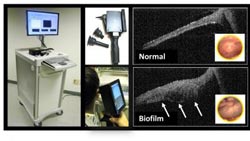Nowhere to hide: New device sees bacteria behind the eardrum

University of Illinois researchers tested a prototype of a new device that can see biofilms behind the eardrum to better diagnose and treat chronic ear infections. Credit: Stephen Boppart<br>
The research team, led by University of Illinois electrical and computer engineering professor Stephen Boppart, will publish their advance in the online Early Edition of the journal Proceedings of the National Academy of Sciences the week of May 28.
Ear infections are the most common conditions that pediatricians treat. Chronic ear infections can damage hearing and often require surgery to place drainage tubes in the eardrum, and problems can persist into adulthood.
Studies have found that patients who suffer from chronic ear infections may have a film of bacteria or other microorganisms that builds up behind the eardrum, very similar to dental plaque on unbrushed teeth. Finding and monitoring these so-called biofilms are important for successfully identifying and treating chronic ear infections.
“We know that antibiotics don't always work well if you have a biofilm, because the bacteria protect themselves and become resistant,” Boppart said. “In the presence of a chronic ear infection that has a biofilm, the bacteria may not respond to the usual antibiotics, and you need to stop them. But without being able to detect the biofilm, we have no idea whether or not it's responding to treatment.”
However, middle-ear biofilms are difficult to diagnose. A doctor looking through a standard otoscope sees only the eardrum's surface, not the bacteria-seeded biofilm lurking behind it waiting to bloom into infection. Invasive tests can provide evidence of a biofilm, but are unpleasant for the patient and cannot be used routinely.
The new device is an application of a technique called optical coherence tomography (OCT), a non-invasive imaging system devised by Boppart's group. It uses beams of light to collect high-resolution, three-dimensional tissue images, scanning through the eardrum to the biofilm behind it – much like ultrasound imaging, but using light.
“We send the light into the ear canal, and it scatters and reflects from the tympanic membrane and the biofilm behind it,” said graduate student Cac Nguyen, the lead author of the paper. “We measure the reflection, and with the reference light we can get the structure in depth.”
The single scan is performed in a fraction of a second – speed is a necessity for treating squirming tots – and images a few millimeters deep behind the eardrum. Thus, doctors can see not only the presence of a biofilm, but also how thick it is and its position against the eardrum.
The paper marks the first demonstration of using the ear OCT device to detect biofilms in human patients. To test their device, the researchers worked with clinicians at Carle Foundation Hospital in Urbana, Ill., to scan patients with diagnosed chronic ear infections, as well as patients with normal ears. The device identified biofilms in all patients with chronic infections, while none of the normal ears showed evidence of biofilms.
“I think this is now a technology that allows physicians to monitor chronic ear infection, and examine better ways to treat the disease,” said Boppart, who is also affiliated with the departments of bioengineering and internal medicine, the Institute for Genomic Biology, and the Beckman Institute for Advanced Science and Technology at the U. of I. “We can use different antibiotics and see how the biofilm responds.”
Next, the researchers plan to investigate different ear pathology, particularly comparing acute and chronic infections, and will examine the relationship between biofilms and hearing loss. They hope that improved diagnostics will lead to better treatment and referral practices.
The researchers hope to make their device – currently a hand-held prototype – even more compact, easy to use, and low-cost. The device company Welch Allyn, based in Skaneateles Falls, N.Y., is a collaborator on the project, which was funded by the National Institutes of Health.
Boppart's group and its collaborators also will work to apply OCT imaging to other areas commonly examined by primary-care physicians. The ear-imaging device is the first in a suite of OCT-based imaging tools that the group plans to develop. Doctors could change the tip of the new OCT device, for example, to look at the eyes, mouth, nose, or skin.
“All the sites that a primary-care physician would look at, we can now look at with this more advanced imaging, ” Boppart said. “With OCT, we are bringing to the primary-care clinic high-resolution 3-D digital imaging and being able to look at many different tissue structures in real-time, non-invasively and in depth.”
“As medicine gets more high-tech, we want to give the front-line doctor the best technology to detect disease early,” Boppart said.
Media Contact
More Information:
http://www.illinois.eduAll latest news from the category: Health and Medicine
This subject area encompasses research and studies in the field of human medicine.
Among the wide-ranging list of topics covered here are anesthesiology, anatomy, surgery, human genetics, hygiene and environmental medicine, internal medicine, neurology, pharmacology, physiology, urology and dental medicine.
Newest articles

A universal framework for spatial biology
SpatialData is a freely accessible tool to unify and integrate data from different omics technologies accounting for spatial information, which can provide holistic insights into health and disease. Biological processes…

How complex biological processes arise
A $20 million grant from the U.S. National Science Foundation (NSF) will support the establishment and operation of the National Synthesis Center for Emergence in the Molecular and Cellular Sciences (NCEMS) at…

Airborne single-photon lidar system achieves high-resolution 3D imaging
Compact, low-power system opens doors for photon-efficient drone and satellite-based environmental monitoring and mapping. Researchers have developed a compact and lightweight single-photon airborne lidar system that can acquire high-resolution 3D…





















